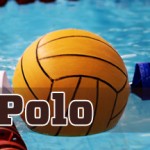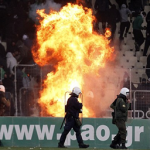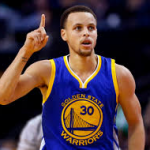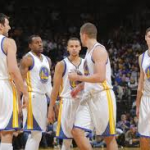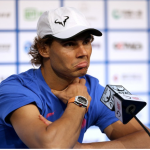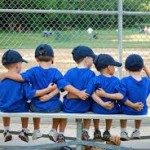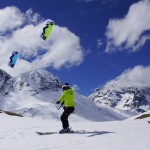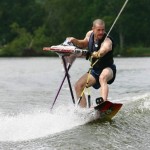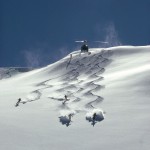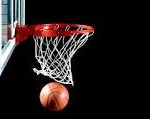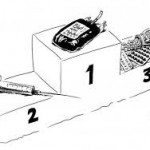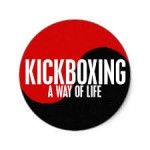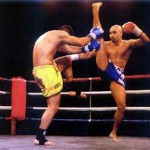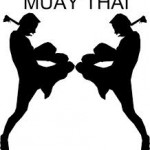By Angelo Dedes and Stathis Konstantakopoulos (B class)
Volleyball is a team sport in which two teams of six players are separated by a net. Each team tries to score points by grounding a ball on the other team’s court under organized rules. It has been a part of the official programme of the Summer Olympic Games since 1964.
The complete rules are extensive. But simply, play proceeds as follows: a player on one of the teams begins a “rally” by serving the ball (tossing or releasing it and then hitting it with a hand or arm), from behind the back boundary line of the court, over the net, and into the receiving team’s court. The receiving team must not let the ball be grounded within their court. The team may touch the ball up to 3 times but individual players may not touch the ball twice consecutively. Typically, the first two touches are used to set up for an attack, an attempt to direct the ball back over the net in such a way that the serving team is unable to prevent it from being grounded in their court.
The rally continues, with each team allowed as many as three consecutive touches, until either (1): a team makes a kill, grounding the ball on the opponent’s court and winning the rally; or (2): a team commits a fault and loses the rally. The team that wins the rally is awarded a point, and serves the ball to start the next rally. A few of the most common faults include:
- causing the ball to touch the ground or floor outside the opponents” court or without first passing over the net;
- catching and throwing the ball;
- double hit: two consecutive contacts with the ball made by the same player;
- four consecutive contacts with the ball made by the same team;
- net foul: touching the net during play;
- foot fault: the foot crosses over the boundary line when serving.
The ball is usually played with the hands or arms, but players can legally strike or push (short contact) the ball with any part of the body.
Serve
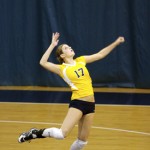 A player stands behind the inline and serves the ball, in an attempt to drive it into the opponent’s court. The main objective is to make it land inside the court; it is also desirable to set the ball’s direction, speed and acceleration so that it becomes difficult for the receiver to handle it properly. A serve is called an «ace» when the ball lands directly onto the court or travels outside the court after being touched by an opponent.
A player stands behind the inline and serves the ball, in an attempt to drive it into the opponent’s court. The main objective is to make it land inside the court; it is also desirable to set the ball’s direction, speed and acceleration so that it becomes difficult for the receiver to handle it properly. A serve is called an «ace» when the ball lands directly onto the court or travels outside the court after being touched by an opponent.
In contemporary volleyball, many types of serves are employed:
- Topspin: an overhand serve where the player tosses the ball high and hits it with a wrist span, giving it topspin which causes it to drop faster than it would otherwise and helps maintain a straight flight path.
- Jump serve: an overhand serve where the ball is first tossed high in the air, then the player makes a timed approach and jumps to make contact with the ball, hitting it with much pace and topspin. This is the most popular serve amongst college and professional teams.
- Jump float: an overhand serve where the ball is tossed high enough that the player may jump before hitting it similarly to a standing float serve. The ball is tossed lower than a topspin jump serve, but contact is still made while in the air. This serve is becoming more popular amongst college and professional players because it has a certain unpredictability in its flight pattern.
Pass
Also called reception, the pass is the attempt by a team to properly handle the opponent’s serve, or any form of attack. Proper handling includes not only preventing the ball from touching the court, but also making it reach the position where the setter is standing quickly and precisely.
The skill of passing involves fundamentally two specific techniques: underarm pass, or bump, where the ball touches the inside part of the joined forearms or platform, at waist line; and overhand pass, where it is handled with the fingertips, like a set, above the head. Either is acceptable in professional and beach volleyball, however there are much tighter regulations on the overhand pass in beach volleyball.
Attack
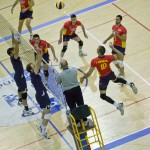
The attack, also known as the spike, is usually the third contact a team makes with the ball. The object of attacking is to handle the ball so that it lands on the opponent’s court and cannot be defended. A player makes a series of steps (the «approach»), jumps, and swings at the ball.
Ideally the contact with the ball is made at the apex of the hitter’s jump. At the moment of contact, the hitter’s arm is fully extended above his or her head and slightly forward, making the highest possible contact while maintaining the ability to deliver a powerful hit. The hitter uses arm swing, wrist snap, and a rapid forward contraction of the entire body to drive the ball. A “bounce” is a slang term for a very hard/loud spike that follows an almost straight trajectory steeply downward into the opponent’s court and bounces very high into the air. A «kill» is the slang term for an attack that is not returned by the other team thus resulting in a point.
Block
Blocking refers to the actions taken by players standing at the net to stop or alter an opponent’s attack.
A block that is aimed at completely stopping an attack, thus making the ball remain in the opponent’s court, is called offensive. A well-executed offensive block is performed by jumping and reaching to penetrate with one’s arms and hands over the net and into the opponent’s area. It requires anticipating the direction the ball will go once the attack takes place. It may also require calculating the best foot work to executing the «perfect» block.
Player specialization
There are 5 positions filled on every volleyball team at the elite level: Setter, Outside Hitter/Left Side Hitter, Middle Hitter, Opposite Hitter/Right Side Hitter and Libero/Defensive Specialist. Each of these positions plays a specific, key role in winning a volleyball match.
- Setters have the task for orchestrating the offense of the team. They aim for second touch and their main responsibility is to place the ball in the air where the attackers can place the ball into the opponents” court for a point. They have to be able to operate with the hitters, manage the tempo of their side of the court and choose the right attackers to set. Setters need to have swift and skillful appraisal and tactical accuracy, and must be quick at moving around the court.
- Liberos are defensive players who are responsible for receiving the attack or serve. They are usually the players on the court with the quickest reaction time and best passing skills. Libero means “free” in Italian—they receive this name as they have the ability to substitute for any other player on the court during each play. They do not necessarily need to be tall, as they never play at the net, which allows shorter players with strong passing and defensive skills to excel in the position and play an important role in the team’s success. A player designated as a libero for a match may not play other roles during that match. Liberos wear a different colour jersey than their teammates.
- Middle blockers or Middle hitters are players that can perform very fast attacks that usually take place near the setter. They are specialized in blocking, since they must attempt to stop equally fast plays from their opponents and then quickly set up a double block at the sides of the court. In non-beginners play, every team will have two middle hitters.
- Outside hitters or Left side hitters attack from near the left antenna. The outside hitter is usually the most consistent hitter on the team and gets the most sets. Inaccurate first passes usually result in a set to the outside hitter rather than middle or opposite. Since most sets to the outside are high, the outside hitter may take a longer approach, always starting from outside the court sideline. In non-beginners play, there are again two outside hitters on every team in every match.
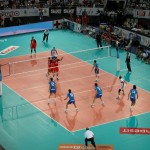
Sources
- en.wikipedia.org
- www.gallaudetathletics.com

